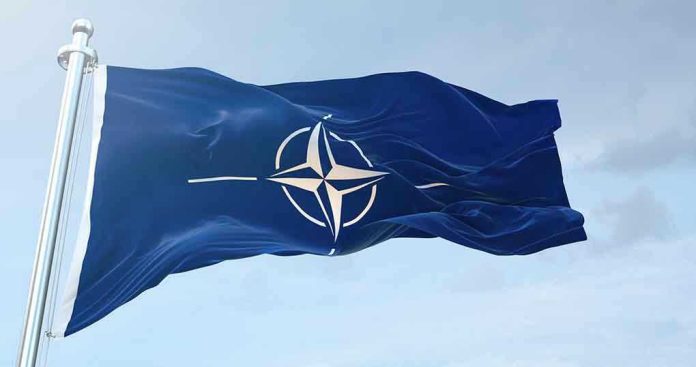
European taxpayers are now footing the bill for U.S. weapons to Ukraine, marking a dramatic shift in NATO burden-sharing and sparking debate over transatlantic priorities.
Story Snapshot
- The Netherlands is the first NATO state to directly fund U.S. weapons for Ukraine under the new Trump-NATO PURL initiative.
- This €500 million commitment signals a major shift, with Europe shouldering more of the Ukraine aid burden.
- The new system enables rapid, recurring deliveries of U.S. military equipment to Kyiv through NATO coordination.
- Other European allies are expected to join, increasing pressure on national budgets and defense priorities.
Dutch Funding Redefines NATO Burden-Sharing
The Netherlands has pledged €500 million—roughly $576 million—to purchase U.S.-made Patriot air defense systems and missiles for Ukraine, becoming the first European NATO member to directly fund Washington’s new supply mechanism for Kyiv. This move inaugurates the NATO Prioritized Ukraine Requirements List (PURL), a program co-designed by President Trump and NATO Secretary General Mark Rutte. The intent is to deliver fast, recurring packages of U.S. equipment, with the Dutch contribution setting the precedent for other NATO allies to follow.
The PURL initiative, launched July 14, 2025, is the Trump administration’s answer to long-standing Republican demands that Europe pull its weight on defense spending. In prior years, U.S. taxpayers bore the brunt of nearly $128 billion in aid to Ukraine, while European allies were often seen as lagging. Now, with the Netherlands stepping up and others like Sweden, Denmark, and Norway announcing their own $500 million joint air defense package, the financial and political calculus of the alliance is changing. The U.S. remains the primary supplier of advanced weapons, but the funding burden is shifting toward European treasuries. NATO is building new logistics hubs to ensure that shipments—especially of crucial air defenses—arrive quickly to meet Ukraine’s battlefield needs.
Political and Economic Implications for the U.S. and Europe
This policy shift comes as the Trump administration faces domestic calls to prioritize American security and curb government overspending. By having European allies underwrite the cost of U.S. weapons, the administration relieves pressure on American taxpayers and boosts domestic defense production. For Europe, however, these new commitments spark debate over defense budgets and national priorities. Taxpayers in the Netherlands and across Europe are now directly funding a foreign war effort, raising questions about transparency, oversight, and the long-term sustainability of such aid. Meanwhile, U.S. defense contractors are poised to benefit from increased export orders, reinforcing America’s industrial and technological lead in military hardware.
For NATO, the PURL mechanism is more than just an aid pipeline—it is a test of alliance solidarity and adaptability. By formalizing European financial support for U.S.-made weapons, NATO leaders aim to deter Russian aggression while addressing criticism that the U.S. has shouldered an unfair burden. The Netherlands’ leadership, with former Prime Minister Rutte now at the helm of NATO, is designed to set an example and encourage other allies to join. However, some analysts warn that a recurring, institutionalized funding mechanism could escalate tensions with Russia, and may entrench Europe’s reliance on American weapons at the expense of its own defense industry. The coming months will reveal how many allies follow the Dutch lead, and whether the alliance can maintain unity under this new model of burden-sharing.
Impact on Ukraine and Broader Security Landscape
For Ukraine, the immediate benefit is clear: enhanced air defense capabilities to counter relentless Russian missile and drone attacks. Ukrainian officials, including President Zelenskyy, have welcomed the Dutch pledge, arguing that better protection for Ukraine means greater security for all of Europe. The first deliveries are expected to arrive by September, with NATO coordinating rapid, recurring shipments based on Ukraine’s urgent needs. The broader impact includes increased pressure on other European nations to contribute, as well as potential ripple effects in domestic politics as taxpayers scrutinize large-scale foreign military spending. Analysts note that while the initiative strengthens NATO cohesion, it also raises the stakes in the ongoing confrontation with Russia, which may respond to increased Western arms deliveries with further escalation.
NEW: The Netherlands is the first NATO country to buy a €500 million U.S. arms package for Ukraine.
It includes air defense systems, ammunition, and other military gear.
The weapons will be delivered to Ukraine as military aid. pic.twitter.com/8UFBK2P2zP
— Clash Report (@clashreport) August 4, 2025
Expert commentary suggests that the PURL initiative could serve as a model for future NATO burden-sharing and rapid response mechanisms. Supporters argue it is a necessary step to deter Russian aggression and support a democratic ally. Critics, particularly in the U.S., contend that Europe should have stepped up sooner—and that America should remain focused on replenishing its own stockpiles and defending its borders. For U.S. conservatives, the shift in financial responsibility aligns with long-standing calls for limited government and fair alliance contributions, but vigilance remains warranted to ensure that constitutional priorities and American interests are not sidelined by international entanglements or unchecked spending abroad.
Sources:
Fox News, Aug 5, 2025: Netherlands becomes first NATO ally to buy US weapons for Ukraine



